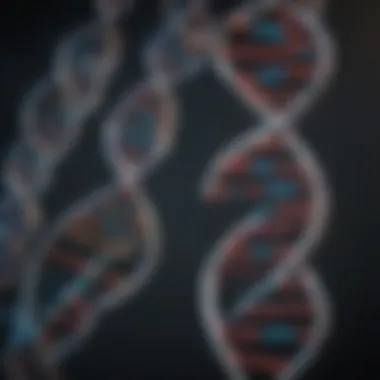Understanding Genetically Modified Organisms: A Detailed Analysis


Article Overview
Purpose of the Article
This article aims to provide a detailed exploration of genetically modified organisms (GMOs). It will dissect the scientific foundation of GMOs, how they are constructed, and the various applications they have in modern agriculture and beyond. The goal is to lay bare the benefits, the challenges, and the ongoing controversies that surround GMOs, particularly in terms of their safety and regulation. Understanding GMOs is crucial for anyone invested in the future of food, agriculture, and biotechnology.
Relevance to Multiple Disciplines
The discussion around GMOs intersects with many fields, including biology, agriculture, public health, and environmental science. Each discipline provides a different lens through which to view GMOs. For instance, biologists will focus on the genetic engineering techniques that create GMOs while agricultural scientists examine their role in enhancing crop yields. Health professionals may be more concerned about the implications of GMOs on human health. Therefore, this article serves as a resource for students, researchers, and professionals across various disciplines, clarifying how GMOs are relevant in each context.
Research Background
Historical Context
The journey of genetic modification began well before the commercial availability of GMOs. The foundational techniques, such as selective breeding, have been used for centuries. However, the advent of modern biotechnology in the 20th century, particularly with the discovery of recombinant DNA technology, marked a significant turning point. In 1994, the Flavr Savr tomato became the first commercially available genetically modified food. Since then, a diverse array of genetically modified crops has entered the market, prompting numerous societal debates about their use and regulation.
Key Concepts and Definitions
To fully understand GMOs, certain concepts are essential:
- Genetic Engineering: A process of altering the genetic makeup of an organism, often involving the transfer of specific genes from one organism to another.
- Transgenic Organisms: Organisms that contain genes from other species, achieving desired traits such as pest resistance or enhanced nutritional content.
- Crops: Plants specifically cultivated for consumption or agricultural purposes, heavily influenced by genetic modification.
Understanding these terms will pave the way for a clearer discussion about the benefits, risks, and ethical implications associated with GMOs.
"The future of food is inextricably linked to the decisions we make today regarding GMOs."
"The future of food is inextricably linked to the decisions we make today regarding GMOs."
This comprehensive analysis seeks to unravel these complexities, making the information accessible for a discerning audience.
What Are Genetically Modified Organisms?
Genetically modified organisms (GMOs) represent a significant evolution in agricultural and biological research. Their definition and implications have become crucial in the contemporary discourse on food security, health, and environmental sustainability. Understanding GMOs involves a multifaceted approach, considering not only the technical aspects of genetic modification but also the broader societal impacts.
Definition and Overview
Genetically modified organisms are living entities whose genetic material has been altered through biotechnology. This manipulation is typically accomplished using various techniques that enable scientists to introduce, enhance, or silence specific genes. Common examples of GMOs in agriculture include crops engineered for pest resistance or enhanced nutritional properties, such as Bt corn or Golden Rice.
The primary purpose of creating GMOs is to improve certain traits, which can lead to benefits such as increased agricultural productivity, reduced dependence on chemical pesticides, and enhanced food quality. GMOs have been designed to withstand harsh environmental conditions, thereby ensuring food security in the face of climate change. Additionally, they can be tailored to provide essential nutrients, which is particularly relevant in regions suffering from malnutrition.
Historical Context
The journey of GMOs began in the mid-20th century with the advent of molecular biology techniques. Initial breakthroughs included the discovery of the structure of DNA and the development of recombinant DNA technology in the 1970s. This enabled scientists to manipulate genes more precisely than ever before.
In 1994, one of the first GMO crops, the Flavr Savr tomato, received approval from the United States Food and Drug Administration. This marked a pivotal moment in agricultural biotechnology. Since then, the adoption of GMOs has accelerated, with millions of hectares worldwide dedicated to genetically modified crops.
While the potential benefits of GMOs are substantial, historical skepticism exists, stemming from concerns about their safety, environmental impact, and ethical considerations. Stakeholders began debating the implications of releasing GMOs into the environment and the long-term effects on human health.
In summary, understanding GMOs necessitates an awareness of their definition, historical development, and the complex dynamics involved in their application and regulation.
Scientific Foundations of Genetic Modification
The scientific foundations of genetic modification are central to understanding the implications and advancements in this field. Genetic modification involves altering the genetic makeup of organisms to achieve desired traits. This has profound implications for agriculture, health, and environmental sustainability.
Basic Genetic Concepts
To truly grasp genetic modification, it is essential to understand some basic genetic concepts. Genes, which are the basic units of heredity, direct the development of traits in organisms. They are composed of DNA sequences that encode for proteins, which perform various functions within a cell. Genetic variation occurs naturally, influenced by mutations, gene flow, and recombination. Genetic modification, however, allows for more targeted changes in an organism's DNA, facilitating the introduction of traits that may not be present in the natural gene pool.
This selective alteration enables scientists to enhance crop yield, improve disease resistance, and even fortify nutritional content. Understanding these genetic principles lays the groundwork for comprehending more complex modifications and their applications.
Techniques Used in Genetic Modification
The techniques used in genetic modification are diverse, each with unique applications and advantages. Three prominent methodologies are CRISPR technology, gene cloning, and the creation of transgenic organisms.
CRISPR Technology
CRISPR technology represents a revolutionary advancement in genetic modification. Its foundational aspect is the ability to edit the genome with precision. The technique harnesses a natural defense mechanism found in bacteria, allowing scientists to target specific stretches of DNA with remarkable accuracy.
The key characteristic of CRISPR is its efficiency and simplicity compared to older methods. It is popular among researchers due to its affordability and speed. A unique feature of CRISPR is its versatility, which can be applied not just to plants but also to animals and even human cells. However, the discussion around ethical implications and potential off-target effects remains a crucial concern.


Gene Cloning
Gene cloning is another vital technique in genetic modification. It involves isolating and replicating specific genes to understand their function or to produce proteins beneficial for various applications. This method allows for the mass production of genetically identical organisms with desired traits.
The central characteristic of gene cloning is its ability to produce organisms that can consistently express specific genetic traits. Its popularity stems from the significant control it offers researchers over genetic changes. A unique feature is that it allows the introduction of new genes into existing varieties, which can enhance agricultural productivity. Nonetheless, concerns about genetic diversity and ecosystem stability arise from its use, prompting further inquiry.
Transgenic Organisms
Transgenic organisms, or genetically engineered organisms, carry one or more genes from a different species altered into their genome. This technique enables the pursuit of traits that are not possible through traditional breeding methods.
The essential aspect of transgenic organisms is the introduction of foreign genes, which can lead to new capabilities, such as pest resistance in crops. They are beneficial in creating species that can thrive in adverse conditions and support food security. A unique feature is the potential for increased efficiency in food production. However, significant debate exists regarding their long-term effects on ecosystems and biodiversity, making ongoing research and discussion necessary.
"Genetic modifications can provide solutions to some of agriculture's most pressing problems, yet they also call into question the ethical grounds on which they stand."
"Genetic modifications can provide solutions to some of agriculture's most pressing problems, yet they also call into question the ethical grounds on which they stand."
These scientific foundations and the techniques used in genetic modification underscore the importance of this area of study. As we advance, understanding these principles will be crucial for integrating GMOs responsibly into various sectors.
Applications of GMOs in Agriculture
The application of genetically modified organisms (GMOs) in agriculture is a pivotal aspect of modern farming practices. These technologies aim to enhance productivity and resilience in crops and livestock. The integration of GMOs can contribute to addressing global food demands, especially as population growth places increasing pressures on agricultural systems. GMOs facilitate various innovations that may lead to increased efficiency and sustainability in food production.
Crop Improvement
Resistant Crops
Resistant crops are engineered to withstand specific challenges such as pests, diseases, and environmental stressors. This innovation is especially valuable in regions where traditional crops frequently fail due to these challenges. The key characteristic of resistant crops is their ability to reduce the reliance on chemical pesticides, which can have a positive impact on both the environment and farm economics. These crops employ traits derived from other plants or organisms, providing them with the necessary defense mechanisms.
One notable example is Bt corn, which has been modified to express a protein from the Bacillus thuringiensis bacterium. This trait allows the corn to resist certain insect pests, leading to fewer chemical applications and potentially higher yields. The advantages of resistant crops include greater food security and lower input costs for farmers. However, there are considerations regarding the potential for resistance development in pests over time, necessitating ongoing research and management.
Nutrient Enhancement
Nutrient enhancement in crops focuses on increasing essential nutrients in food. This approach aims to combat malnutrition and improve overall health outcomes in populations that rely heavily on staple foods. A prime example is Golden Rice, which has been fortified with vitamin A through genetic modification. This characteristic is vital in regions where dietary deficiencies are prevalent.
The primary benefit of nutrient enhancement lies in its ability to address deficiency-related health issues, such as blindness caused by vitamin A deficiency. Moreover, enhanced crops are perceived as beneficial because they can bolster dietary diversity and nutrition without requiring significant changes to agricultural practices. Nonetheless, there are discussions around consumer acceptance and the perceptions of genetically modified food that need continued engagement.
Livestock Modification
Livestock modification seeks to improve the health and productivity of animals used in agriculture. Techniques such as genetic selection and modification aim to enhance traits like growth rates, disease resistance, and feed efficiency. A significant aspect of livestock modification is the potential to reduce the environmental footprint of animal agriculture. For instance, genetically engineered animals may require less feed for the same level of productivity, which could lessen resource use overall.
Such modifications can support more efficient meat and dairy production systems, which is critical given the increasing global demand for protein. However, ethical considerations related to the welfare of genetically modified animals and public perception of such technologies must also be addressed. The future of livestock modification is not only about improving yields but also about ensuring ethical standards and consumer trust.
Benefits of GMOs
The discussion around genetically modified organisms (GMOs) is often laden with complexity. However, understanding the benefits of GMOs is essential to assess their role in modern agriculture and food production. GMOs offer a variety of advantages that address food security, environmental sustainability, and economic growth. These benefits form the backbone of ongoing debates regarding their necessity and efficacy in contemporary society.
Increased Yield
One of the primary benefits of GMOs is the potential for increased agricultural yield. Genetic modification allows scientists to introduce traits into crops that enhance their ability to withstand adverse conditions. This could mean higher resilience to drought, pests, and diseases. For example, Bacillus thuringiensis (Bt) corn has been modified to include a gene from the bacterium that produces a protein toxic to specific pests, effectively reducing crop loss from insect damage.
Research indicates that GMO crops can yield significantly more per acre than their non-GMO counterparts under similar growing conditions. This increase is crucial for feeding a growing global population, projected to reach nearly 10 billion by 2050. Farmers, facing land constraints, need solutions that maximize production on existing farmland.
Furthermore, improved yield contributes to economic stability for farmers. Increased harvests mean higher profits and can help alleviate poverty in farming communities. Thus, the economic implications extend beyond the rural landscape, influencing food prices and availability on a larger scale.
Sustainability and Environmental Impact
The sustainability narratives often surrounding GMOs focus on their potential to reduce farming's environmental footprint. Genetically modified crops can require fewer chemical pesticides and fertilizers. For instance, pest-resistant varieties reduce the need for harmful chemicals, promoting less pesticide application and minimizing ecological damage.
Moreover, GMOs often contribute to better soil health and biodiversity. Some crops are engineered to work well with conservation tillage practices, which helps preserve soil structure and organic matter. Healthier soil ecosystems often lead to reduced erosion and improved water retention.
Another aspect is the development of crops that can thrive in suboptimal conditions, such as extreme weather patterns intensified by climate change. These advances make agriculture resilient and can contribute to stable food supplies, even in shifting environmental scenarios.
In summary, the benefits of GMOs span across higher yields, economic benefits for farmers, and various environmental advantages. The potential for GMOs to create a sustainable agricultural future makes them a vital component of present and future food systems.
"As the global population continues to grow, GMOs present significant opportunities for enhancing food security."
"As the global population continues to grow, GMOs present significant opportunities for enhancing food security."
Understanding these benefits is crucial for informed discussions on the role of GMOs, especially in the context of global challenges in food production and environmental preservation.
Controversies Surrounding GMOs


The discussions about genetically modified organisms often evoke strong opinions. Understanding the controversies surrounding GMOs is crucial, as they highlight significant aspects that influence public perception, policy, and scientific research. The debate focuses on health concerns and environmental risks, which continue to shape both consumer choices and agricultural practices. Analyzing these controversies helps elucidate the broader implications of GMOs in food production and sustainability efforts.
Health Concerns
Health concerns related to GMOs are among the most polarizing topics in the discussion of biotechnology in agriculture. Many argue that GMOs may introduce new allergens or exacerbate existing food allergies. The key characteristic of allergenicity centers around the risk that genetically modified foods might contain proteins that were not present in non-GMO varieties. This unpredictability raises questions about safety, leading to public skepticism. The unique feature of allergenicity in GM foods is that it does not always produce immediate effects; long-term allergic responses remain a central worry.
Long-term Effects
The long-term effects of consuming GMOs have yet to be definitively established. Users might prefer to know the potential implications of long-term exposure to genetically modified products, thereby understanding their health impact. The key characteristic of long-term effects discussions is the current lack of comprehensive longitudinal studies assessing health outcomes associated with GM food consumption. Researchers often find it challenging to isolate variables and establish clear causal links, leading to considerable uncertainty. As a result, potential disadvantages of GMOs include persistent consumer mistrust and calls for more rigorous long-term studies in the future.
Environmental Risks
Concerns about environmental risks associated with GMOs often center on biodiversity loss and the potential for developing resistant pests or weeds. The fear is that monoculture practices might lead to decreased genetic variation within crop systems and surrounding ecosystems. The key characteristic of biodiversity loss is the reduction of native species as genetically modified crops dominate agricultural landscapes. While GMOs can enhance productivity, the long-term ecological balance may suffer, impacting entire habitats.
Resistance Development
The concept of resistance development is another significant concern related to environmental risks. As certain crops are modified to be resistant to pests or herbicides, there is a risk that target organisms may evolve resistance over time. This development can lead to a self-perpetuating cycle where farmers increasingly rely on chemical treatments, potentially leading to greater ecological harm. The unique feature of resistance development illustrates the delicate balance between agricultural advancement and environmental sustainability, prompting calls for integrated management strategies rather than solely relying on genetic modification.
"Understanding the controversies surrounding GMOs is essential for informed discussions on agricultural policies and practices."
"Understanding the controversies surrounding GMOs is essential for informed discussions on agricultural policies and practices."
The careful examination of these concerns reveals key insights into the complex nature of GMOs. Ensuring that both potential health implications and environmental consequences are thoroughly assessed is critical for progressing in biotechnological applications in agriculture. Through this analysis, stakeholders can approach the future of GMOs with a balanced awareness of both benefits and risks.
Regulatory Framework for GMOs
The regulatory framework for genetically modified organisms (GMOs) is crucial in shaping the landscape of biotechnology and food production. It governs the processes involved in the development, testing, and commercialization of GMOs. The importance of a well-defined regulatory system cannot be overstated, as it addresses safety, environmental impact, and ethical considerations related to GMOs. In today's food industry, it is essential for maintaining public trust and ensuring the responsible use of technology.
Global Regulations
Across the world, the regulations surrounding GMOs vary significantly. Different countries have established their own laws and guidelines that influence how GMOs are developed and used. For instance, in the United States, the US Department of Agriculture (USDA), the Food and Drug Administration (FDA), and the Environmental Protection Agency (EPA) play critical roles in overseeing GMOs. These agencies assess safety and environmental impact before GMOs can be released into the market.
In contrast, the European Union (EU) employs a more stringent approach. EU regulations prioritize consumer protection and environmental safety through rigorous testing and labeling requirements. Under EU law, every GMO must go through an extensive risk assessment process. This red tape aims to ensure the safety of GMOs before entering the food supply, resulting in lower public acceptance in Europe than in other regions.
"Regulations can help ensure that GMOs contribute to societal well-being while minimizing potential risks."
"Regulations can help ensure that GMOs contribute to societal well-being while minimizing potential risks."
Countries such as Brazil and India also have their own frameworks emphasizing both innovation and safety. The comparative analysis of these regulatory systems illustrates the diverse approaches to managing GMO technology around the world.
Labeling and Consumer Right to Know
Another significant element of GMO regulation is labeling. Labeling policies provide consumers with the information they need to make informed choices about the foods they consume. Many advocates believe that consumers have a right to know what they are eating and whether their food contains GMOs. In some regions, such as the EU, all foods that contain GMOs must be labeled accordingly. This allows consumers to choose products according to their personal or ethical beliefs.
Conversely, in countries like the United States, labeling laws are currently less stringent. Some states have implemented their own labeling schemes, but there is no federal requirement for GMO labeling at present. This disparity creates confusion and challenges for consumers wanting to make informed choices. As global perspectives on GMOs evolve, the discussion surrounding labeling is bound to intensify.
Ethical Considerations
The topic of ethical considerations in genetically modified organisms (GMOs) is critical to understanding their implications in society. These considerations shape the discourse around GMOs and influence public opinion, policy-making, and research funding. Assessing the ethics surrounding GMOs is therefore not only relevant but necessary in the quest for sustainable agricultural practices and food security.
Animal Welfare
Animal welfare is a significant ethical concern when it comes to GMO applications, especially in livestock modification. As biotechnology advances, there are questions regarding the treatment and rights of genetically modified animals. Some modifications aim to improve growth rates, disease resistance, or even reproduction efficiency. However, these enhancements raise issues about the animals' quality of life and their natural behaviors.
Critics argue that altering an organism’s genetic makeup can lead to unforeseen health issues and could compromise the animal's welfare. For instance, genetically modified chickens with enhanced growth traits may suffer from health complications due to rapid size increases. Thus, the ethical implications of such modifications need thorough assessment to ensure that animal welfare is prioritized.
Moreover, there is a trend toward the creation of animals genetically engineered to exhibit desirable traits. The question arises: at what cost to their natural living conditions and behaviors? Ensuring adherence to rigorous ethical standards in the genetic modification of livestock is essential. It is vital for producers and researchers alike to balance innovation with the ethical obligation of treating animals with respect and care.
Equity in Food Distribution
Equity in food distribution is another important ethical consideration tied to GMOs. The potential of genetically modified crops to enhance food security is widely recognized. However, the introduction of GMOs into agriculture can exacerbate existing inequalities unless managed properly. The benefits of GM technology often are not evenly distributed, possibly favoring wealthier farmers and agribusinesses. Poor farmers, particularly in developing countries, may lack access to the technology necessary to leverage these advancements.
Additionally, there are concerns about the monopolization of food sources by a few large corporations that control patented GMO seeds. This raises ethical questions regarding food sovereignty, where local communities may lose control over their food systems. It is crucial to address these disparities to ensure that GMO benefits reach those who are most in need.
A potential solution lies in promoting equitable access to GMO technology among all farmers. Policymakers should consider incentives that allow smallholder farmers to adopt these innovations. Creating a balance that encourages technological advancement while promoting fair access is essential as we navigate the ethical landscape of GMOs.
“The challenge is to balance innovation with ethical obligations to society, animals, and the environment.”
“The challenge is to balance innovation with ethical obligations to society, animals, and the environment.”


In summary, ethical considerations surrounding GMOs encompass multiple factors, including the welfare of genetically modified animals and the equitable distribution of food resources. A thoughtful approach to these issues will ensure that advancements in genetic modification serve the greater good while respecting both animal rights and social justice.
Emerging Trends in GMO Research
Research into genetically modified organisms is rapidly evolving, revealing new techniques and applications that have profound implications for agriculture and food production. Emerging trends in GMO research often drive discussions about biotechnology's role in addressing pressing global challenges such as food security and sustainability. Understanding these trends is crucial for comprehending the future direction of genetic engineering.
Gene Editing Techniques
Base Editing
Base editing is an advanced technique that allows scientists to make precise modifications to the genome without causing double-strand breaks. This method is prized for its ability to convert one DNA base into another with high efficiency and accuracy. Unlike traditional gene editing tools such as CRISPR, base editing does not rely on cuts, reducing the potential for unintended changes in the genome. As a result, it is seen as a beneficial choice for producing genetically modified organisms that require targeted genetic alterations with minimal risk.
The unique feature of base editing is its ability to precisely edit sequences at the single base pair level. This characteristic represents a significant advancement in genetic modification as it allows for more refined changes that could enhance traits such as disease resistance or stress tolerance in crops. However, despite its advantages, there are concerns about off-target effects, although they appear to be less frequent than with older methods.
Prime Editing
Prime editing is another revolutionary gene-editing approach that enables direct writing of genetic information into a specified DNA site. It is considered a "search-and-replace" method that can correct mutations without the necessity for double-strand breaks, presenting fewer risks compared to conventional techniques.
The key characteristic of prime editing lies in its versatility. This method can achieve a wide range of edits, including insertions, deletions, and substitutions, making it a powerful tool for researchers seeking to modify organism properties. Its advantages include enhanced precision and a potentially lower occurrence of unintended mutations. However, it is still a developing technology, and there are significant challenges remaining in terms of delivery and efficiency in plants.
Integration with Biotechnology
The integration of genetic modification with biotechnology represents a cutting-edge area of research that aims to accelerate the development of GMOs with enhanced capabilities. This confluence of disciplines allows for the exploration of diverse applications, including the enhancement of crop resilience and productivity through bioengineering. The collaboration between various fields of science, such as molecular biology, agriculture, and computational modeling, is crucial for pushing the boundaries of what is possible with GMOs.
The synergy between genetic research and biotechnology leads to a more comprehensive approach to addressing agricultural challenges. It enhances the ability to develop crops that are not only high-yielding but also environmentally sustainable. This integration holds the promise of creating food systems that can better withstand climate change and evolving pest pressures. However, as these technologies advance, ongoing dialogue about ethical considerations, potential risks, and regulatory frameworks remains vital.
"Emerging trends in GMO research highlight the intersection of technology and practicality, blending scientific advancement with the urgent need for sustainable solutions in agriculture."
"Emerging trends in GMO research highlight the intersection of technology and practicality, blending scientific advancement with the urgent need for sustainable solutions in agriculture."
The perception of biotechnology continues to evolve as new methods are developed and more is understood about the long-term effects of genetic modifications in agriculture. Researchers, policymakers, and the public must remain engaged in these discussions to navigate the future of food production responsibly.
Public Perception and Consumer Attitudes
Public perception and consumer attitudes toward genetically modified organisms (GMOs) are crucial for understanding the broader implications of genetic modification in our food systems. This topic holds particular significance due to its influence on regulatory decisions, market dynamics, and ultimately, agricultural sustainability. As GMOs play an increasing role in food production, the understanding of public sentiment becomes vital. It informs policymakers and stakeholders about the necessity of transparency and trust in agricultural innovations.
Survey Data and Trends
Recent survey data indicates varying levels of acceptance of GMOs across different demographics. Studies have shown that attitudes towards GMOs are often shaped by personal values, education level, and cultural background. For instance, a survey conducted by the Pew Research Center found that about 39% of Americans believe that GMOs are safe to eat, while 51% expressed concerns regarding their health impact. This dichotomy illustrates a critical gap between scientific consensus and public perception.
Uncovering trends in consumer attitudes reveals shifting perspectives over time. Factors such as media coverage, educational initiatives, and direct consumer experiences could enhance or diminish acceptance. In many regions, especially Europe, there exists a marked skepticism about GMOs, often driven by historical food safety scandals. Consequently, monitoring these trends is essential for understanding the evolving landscape of public attitudes.
Influences of Misinformation
Misinformation significantly affects public perceptions of GMOs. In the age of instant access to information, social media platforms can propagate unverified claims rapidly. This miscommunication not only heightens fear but also shapes opinions without grounding in scientific evidence. Studies have suggested that misinformation can lead to confusion regarding GMO safety, contributing to negative consumer attitudes.
Furthermore, influential narratives often focus on potential risks while downplaying the benefits of GMOs. For instance, exaggerated claims about allergenicity or environmental harm frequently dominate discussions, overshadowing scientific reassurances about regulatory oversight and safety testing. It is critical for advocates of GMOs to engage in effective communication strategies that address these misconceptions through clear, evidence-based messaging.
"The challenge for GMO advocates is not just to present facts, but to connect those facts to the values and concerns of the public."
"The challenge for GMO advocates is not just to present facts, but to connect those facts to the values and concerns of the public."
Future of GMOs in Food Production
The future of genetically modified organisms (GMOs) in food production is critical to understanding agricultural advancement and food security. As global populations rise, the need for efficient, sustainable agricultural practices becomes more pronounced. GMOs play a vital role in addressing these challenges by improving crop resilience, enhancing nutritional content, and reducing environmental impact. The innovations in this field could reshape how we approach food production over the coming decades.
Innovations on the Horizon
Research into GMOs is continually evolving, with promising innovations on the horizon that may alter food production methods significantly.
- Plant Breeding Techniques: New methods such as gene editing, particularly CRISPR, are enabling precise modifications to crops. This leads to the development of varieties that can withstand extreme weather, pests, and diseases better than their non-GMO counterparts.
- Biofortification: There is a clear trend toward enhancing the nutritional value of crops. Examples include Golden Rice, engineered to contain higher levels of Vitamin A, which can combat vitamin deficiencies in some populations.
- Sustainable Practices: Advances in genetic modification can lead to crops that require fewer chemical inputs, such as fertilizers and pesticides, contributing to a more sustainable agricultural system.
"Innovations in GMOs not only promise increased yields but also present opportunities for more sustainable farming practices that may benefit both the economy and the environment."
"Innovations in GMOs not only promise increased yields but also present opportunities for more sustainable farming practices that may benefit both the economy and the environment."
These innovations reflect a commitment to improving global food systems while addressing the urgent challenges posed by climate change and feeding a growing world population.
Role of Policy in Advancement
For GMOs to fulfill their potential in food production, effective policy frameworks are essential. Regulatory bodies must navigate the complexities surrounding GMOs and provide clear guidelines that support research and development while ensuring public safety.
- Support for Research Funding: Governments can facilitate advancements in GMO technologies through funding and grants for research projects, thus stimulating innovation in agriculture.
- Regulatory Clarity: Clear and transparent regulations can help researchers and farmers understand the requirements for growing and selling GMO products. This is crucial for building consumer trust and acceptance.
- Public Engagement: Engaging the public in discussions about GMOs can help demystify the science behind genetic modification. Providing accurate information may alleviate some public misconceptions and hesitations surrounding the use of GMOs in food production.
Ultimately, policy plays a pivotal role in not only advancing scientific research but also ensuring that the societal implications of genetic modifications are appropriately managed.
The landscape of GMOs is ever-changing, influenced by scientific discoveries, public opinion, and policy decisions. Understanding these elements will be crucial in determining the future of GMOs and their place in sustainable food production.



